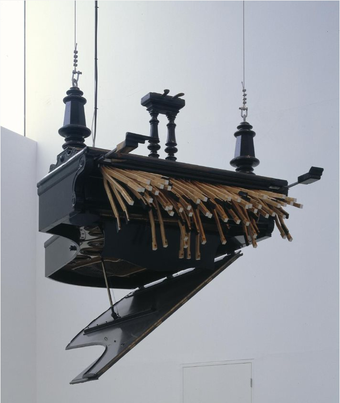Previously on display as part of The Tanks
Objects take on a life of their own in Rebecca Horn’s work
Rebecca Horn's films and sculptures turn familiar materials, gestures and settings into strange, emotionally charged scenes.
In the late 1960s, Horn began to create wearable sculptures. She later used these ‘body extensions’ in staged actions performed for the camera. The isolation and restraint she felt while confined to bed due to illness inspired these works. She designed them to experiment with how the body moves, senses its surroundings and relates to other people.
Horn went on to pair these performances with poetic texts, enhancing their dreamlike effect. Berlin Exercises in 9 Parts: Dreaming under Water 1974–5 is a film set in a single room. Through a series of gestures, Horn transforms this space into a theatrical set, a cage, a playground and a love nest.
Her interest in out-of-the-ordinary movements led Horn to develop mechanical sculptures. With them she could explore actions beyond the limits of the human body and mimic animal behaviours. The objects in these works often act in unexpected ways. By the 1980s Horn was making works large enough to surround the viewer, turning her sculpture into tense animated environments. The sound produced by Horn’s mechanical sculptures is key to the immersive experience of her work.
Curated by Valentina Ravaglia with Andrea Lissoni
Tate Modern

